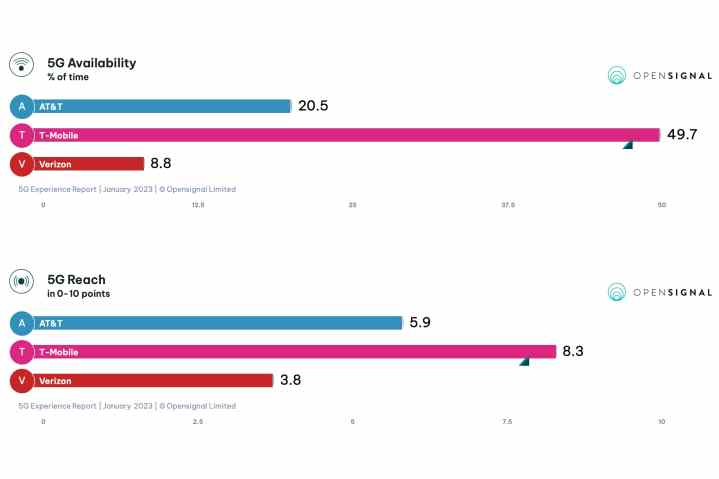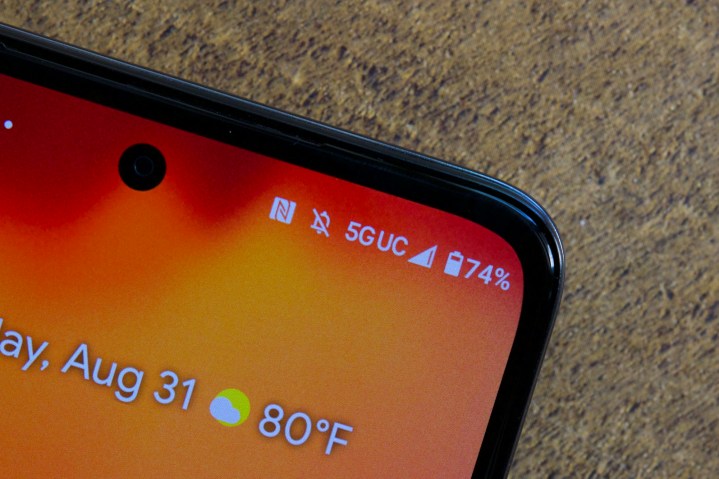T-Mobile continues to command a massive lead in offering the best 5G experience among U.S. carriers. A few weeks ago, a report from Ookla revealed that T-Mobile is leaving its rivals in the dust; now Opensignal has confirmed that not only is the Un-carrier’s lead increasing in raw speeds, but it’s leading the way in taking 5G into the mainstream.
According to Opensignal’s latest 5G Experience Report, T-Mobile not only offers the fastest 5G experience in the U.S. by a sizeable margin but on average, customers on T-Mobile spend nearly 50% of their time on the carrier’s 5G network.
Reaching for the best 5G coverage

Specifically, Opensignal notes that users of T-Mobile’s 5G service connect to 5G 49.7% of the time. While that still means there are large areas out of the reach of T-Mobile’s 5G service, that availability is nearly 30 percent better than the second-place contender, AT&T (20.5%), and an order of magnitude better than what Verizon customers experience, which is only being connected to 5G around 8.8% of the time.
Unlike 5G performance, where T-Mobile lands in a close second in some states, T-Mobile wins on availability in every one of the 49 states where Opensignal conducted its analysis (Alaska was not on the list, for whatever reason).

T-Mobile also had a healthy lead when it came to 5G Reach, a metric that measures how often everyday users get 5G in the places that matter most to them, with a score of 8.3 out of 10, compared to AT&T’s 5.9 and Verizon’s 3.8. However, while T-Mobile still held the advantage for 5G Reach in 48 states, it was virtually neck-and-neck with AT&T in Arkansas.
In practical terms, this means that T-Mobile users connect to a 5G network in more than eight out of ten locations they visit.
While Opensignal’s latest 5G Experience Report covers all flavors of 5G — low-band, midband, and mmWave — a July 2022 report revealed that T-Mobile 5G customers were likelier to find themselves spending time on its fastest 5G Ultra Capacity network. In those comparatively fewer places where 5G service is available on AT&T and Verizon, you still may be getting low-band 5G, which offers speeds that aren’t much better than 4G/LTE service.
T-Mobile 5G is getting even faster

Not surprisingly, T-Mobile is way out in front when it comes to offering the fastest 5G download speeds. Confirming what we heard from Ookla earlier this month, Opensignal reports that T-Mobile users experience average 5G download speeds nearly 100Mbps faster than on Verizon.
While the 186.3Mbps speeds measured by Opensignal weren’t quite as impressive as the 216.56Mbps that Ookla reported, the averages were consistent across all three carriers, meaning the spread was about the same. Verizon came in at 84.9Mbps, and AT&T clocked in at 71.1Mbps.
The race was much tighter when it came to upload speeds. T-Mobile averaged 17.9Mbps, while Verizon came in a close second at 16.1Mbps, and AT&T trailed behind at 12.2Mbps. Interestingly, Opensignal notes that Verizon has closed the gap slightly in this area, from 3.8Mbps in the last report to only 1.9Mbps this time around.
Verizon still has a slight edge in one area

Although T-Mobile is well ahead in raw speed and coverage, Verizon did edge it out in the experiential metrics: 5G video, gaming, and voice app performance.
When it comes to the 5G Video Experience, Opensignal declared Verizon the sole winner — but only by a hair. Verizon scored 67.2 out of 100, while T-Mobile was only 0.3 points behind at 66.9. AT&T lagged behind at 60.5. 5G Video Experience is intended to determine how well adaptive bitrate streaming works over 5G to provide smooth video streaming in resolutions of up to 4K.
Verizon continued to hold its lead in the 5G Games Experience and 5G Voice App Experience categories. It’s still the only carrier in the U.S. where users deem their gaming experience as acceptable and relatively lag-free and where users report no significant quality impairments when conducting calls over mobile voice apps such as WhatsApp, Skype, and Facebook Messenger.
The 5G race is now a marathon rather than a sprint

It’s been over a year since AT&T and Verizon got the green light to roll out their new C-band spectrum. This initiative promised to deliver faster 5G performance and greater capacity to many more areas throughout the U.S.
The C-band rollouts did deliver well on that promise at the outset, particularly for Verizon, which used it to expand its 5G Ultra Wideband network to more than 100 million people in 1,700 cities practically overnight — a considerable boost to the formerly pure-mmWave network that had been confined to the downtown cores of around 82 cities.
However, T-Mobile was already well ahead of both Verizon and AT&T thanks to the midrange 2.5GHz spectrum it picked from its early 2020 merger with Sprint. While the other two carriers were still waiting for the Federal Communications Commission (FCC) to free up some new midrange spectrum, T-Mobile already had a sizeable chunk of those frequencies that it began rolling out nearly two years earlier.
While many analysts expected the new C-band spectrum would quickly level the playing field, allowing the other carriers to catch up to T-Mobile, that hasn’t happened yet. Verizon hasn’t expanded much beyond its initial aggressive C-band push in early 2022, and AT&T has taken an even more conservative approach, rolling out C-band as part of its 5G+ network to only a handful of cities. By all reports, AT&T is biding its time until it can deploy a less controversial C-band spectrum that won’t risk interference with aviation equipment, at which point it may begin to at least catch up to Verizon.
However, T-Mobile hasn’t been sitting still in the meantime. The Un-carrier is continuing to build out its fastest 5G Ultra Capacity network, which already covers 260 million people and is expected to reach 300 million by the end of 2023.
Editors' Recommendations
- T-Mobile’s huge lead in 5G speeds isn’t going anywhere
- Your Verizon plan just got a major overhaul — here’s what’s new
- Live in a rural area? Verizon 5G is about to get better for you
- T-Mobile’s 5G is still unmatched — but have speeds plateaued?
- Moto G Power 5G adds a flagship feature to a budget phone




